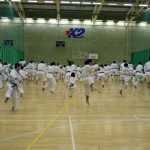This year’s autumn course at the K2 Sports Arena in Crawley was action packed and technically detailed. JKA England’s Ohta Sensei 7th Dan was joined by two special guests: Ogura Sensei 7th Dan from JKA HQ Tokyo, and by Sawada Sensei 7th Dan of JKA Belgium. Here’s a little sample of what took place.
Sawada Sensei led the first session of the course. We worked on oi tsuki to start with, concentrating on losing unnecessary tension, using kime just at the end, and on launching techniques with length and speed. Then we worked on our Tekki kata. A series of exercises, including kiba dachi with yoko tsuki, illustrated how correct positioning of the feet is essential to the stability of this stance. We also concentrated on use of the abdomen to make power, and tried to free up those all too easy to tense shoulders. Drills using yoko empi and various blocking techniques in kiba dachi, with shifting, turning and speed changes, were exhausting but useful. Sawada Sensei’s session also included applications from Tekki 1, 2 and 3 plus some interesting discussion about the origins of Tekki. One idea is that its emphasis on attacks and blocks to the sides could be reflective of the days when warriors wore armour consisting of metal plates tightly laced together. With some of the joints left uncovered, the armour’s construction left the warriors more vulnerable to attacks from the sides.
Ogura Sensei, the kata coach for Japan’s JKA National Team, taught us a number of kata as the course progressed. These including Jitte, Bassai Dai, Tekki Nidan, Tekki Sandan, Sochin and Kanku sho. Kanku Sho lent plenty of opportunities to practise jumping, going to ground (ducking), and springing up. We didn’t quite manage the springing up part as energetically as Sensei, though there were plenty of comedic groans as we made our best efforts. In Jitte, Sensei showed us the importance of suppleness and strength to make the yama gamae (mountain posture) sequences towards the end, and demonstrated beautifully smooth timing changes for the bo uke section. In Sochin, we concentrated on showing the detail of each movement and on holding back the upper body, saving the release of energy until the focal point of our techniques.
Both Sawada Sensei and Ohta Sensei incorporated kumite drills into their sessions. Sawada Sensei taught us about the use of the back hand for the guard, as a means to exert pressure and of hiding attack. Working with a partner, we practised moving forward, tempting the opponent to attack, then blocking that attack early on and moving in to score first. Sensei reminded us that it’s not always necessary to back off when you are blocking. Ohta Sensei had us working on timing, reactions, coordination and distancing as he built up an initially simple but eventually tricky five step kumite sequence. With each step, our opponent increased the number of punches that we had to cope with. There was little or no thinking time between attacks, so crispness and reliance on natural reactions was the only way to stand a chance of keeping up.
There will be another JKA England International Course in May 2013. But before that, there are a number of special one day courses to look forward to, including on 1st December 2012 at Hatfield. You don’t have to be a black belt to attend, participants are split into groups according to their level, and the instruction is truly world class.
Sasha





















